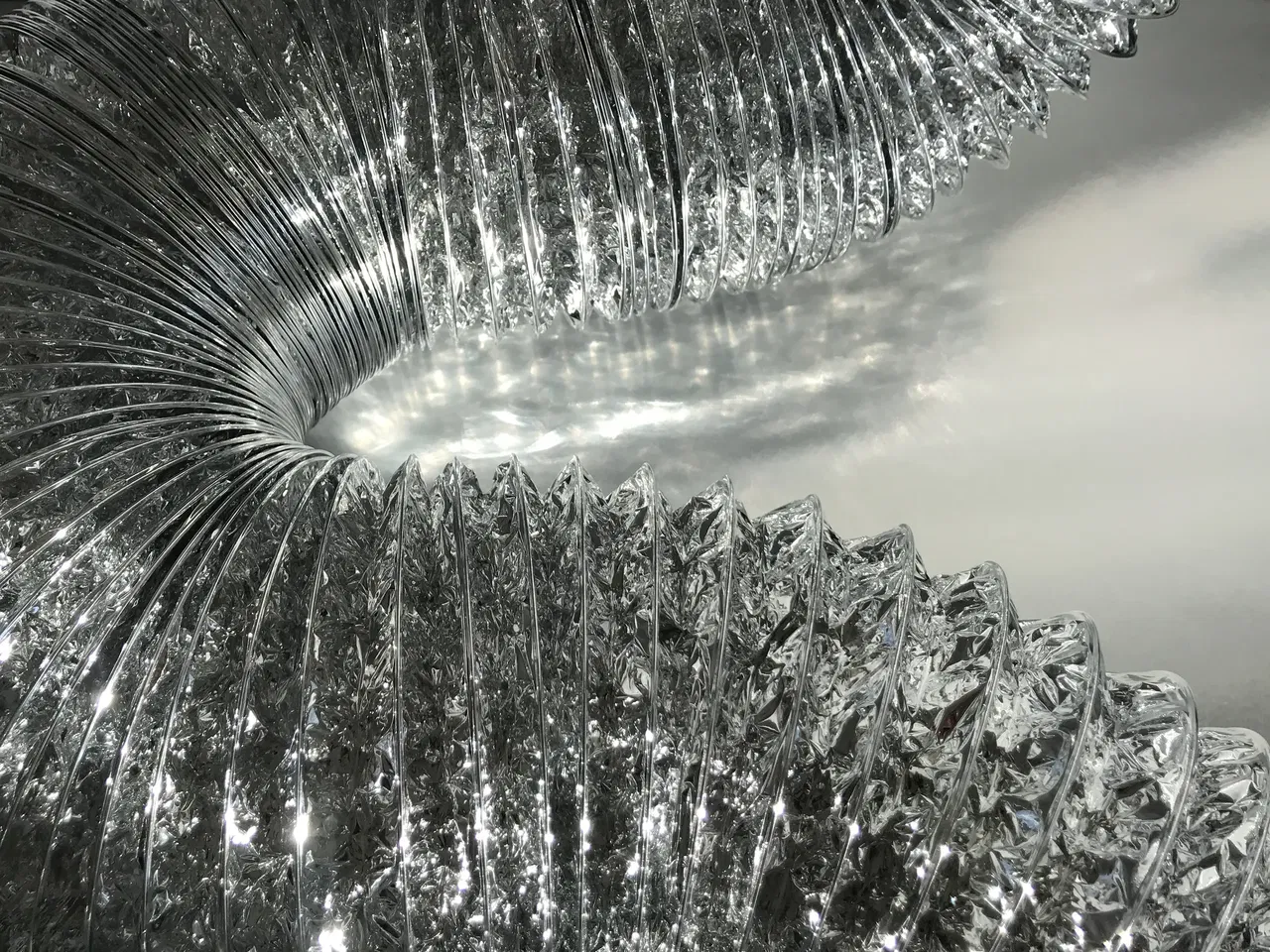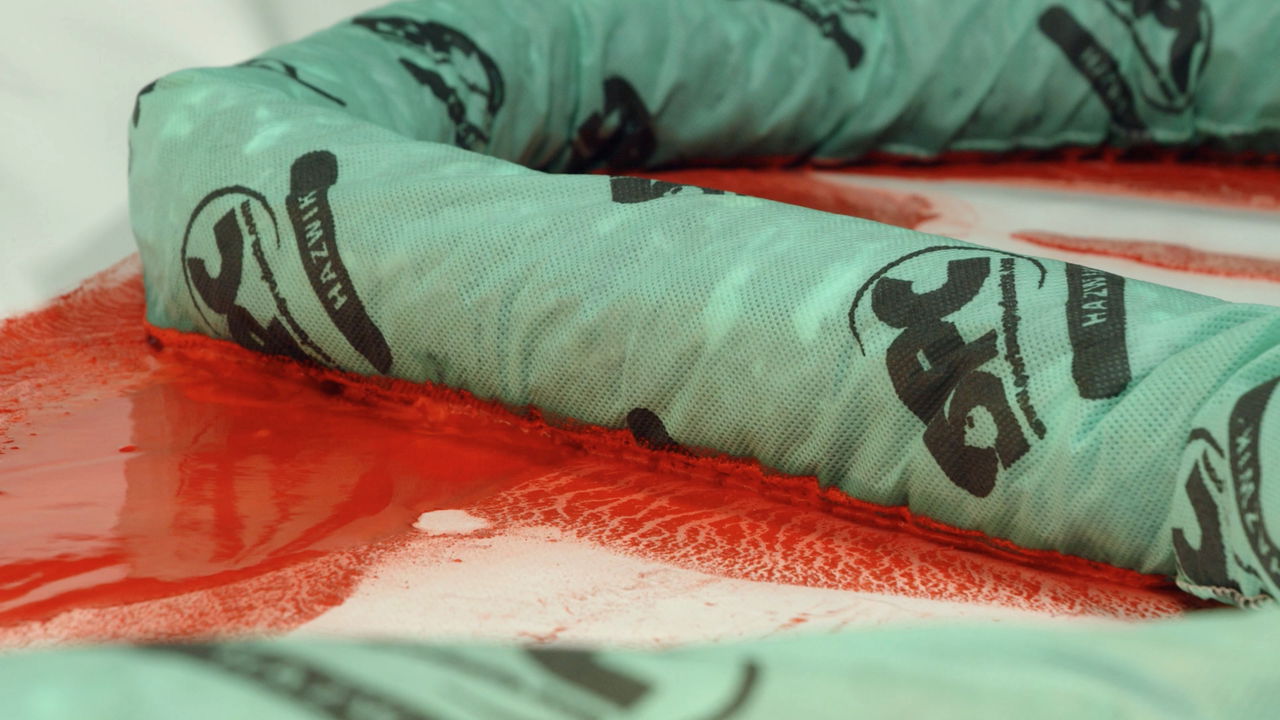
This piece is written for the exhibition Marte Eknaes, Air Conditions, on view from 15 October–23 November 2020 at Kunsthall Stavanger.
At the moment, all of the sculptures for your exhibition are sitting in the Kunsthall, waiting to be installed. Some of the sculptures are inflatable, which strikes me as very practical in these circumstances.
The economical space is part of it, but they can also change shape. They are very sturdy, made for boating: one of them spent two months floating in a fjord so it’s dirty now. This one will be shown deflated, it looks damaged.
Was that originally part of another project?
Yes. A work will often be made for one place and it learns things that then become part of it. These change when it moves into the next situation: the work becomes adaptable. I always found the idea of unquestioned site-specificity problematic: it can be a very subjective and superficial way to analyse a site. What about the underlying structures that are shaping it? The notions of local, global and regional have become a bit of a blur now. Rather there are networks, repetitions and chains moving between places, like a franchise, so maybe my sculpture has this franchise quality to it. It learns something and adjusts to each new space and time.
Despite the material specificity of your sculptures, they act like decoys that actually refer to other broader concerns or difficulties, which become visible through association.
And also through exaggeration. For one of the works in Stavanger, I wanted to extend the Kunsthall’s air ventilation system into the exhibition space itself, but what should it look like? You can make a lot of aesthetic decisions about a pipe with no technical requirements other than the passage of air. I chose a flexible aluminum tubing that ends up on a plinth, and it has these homemade sci-fi associations, or it’s like a very thin version of Jeff Koons, but it is also just a basic tube system.
An ambivalence occurs through this clustering of associations.
There are also unpredictable elements in outsourcing the production of the inflatables, or trying to connect to the ventilation system. There was a lot of back and forth, speaking with technical people who don’t have time to engage with, or are not interested in my line of thinking. I have to learn something or try to fit into a system I don’t understand. The people who devise the systems that we live in become part of my process, but they are not really conscious of it, which leads to corruption and compromise. This work is about air being pulled in and out, the literal connection between the inside and the outside, but there is a magical aspect of the system that I like too: this vortex idea. There is a transformation between the system, or the building, and the plinth where it is sitting as a sculpture.

Your sculptures have a lot to do with the physical processes that they utilise — inflation, air conditioning, insulation, absorption — which in turn refer to equivalent, broader processes beyond them.
One recent series of works are basically cut-off pieces of insulation material. They carry marks and dirt from the construction site I found them on, or patterns pressed in to their surface by tools, and then I made some additional minor interventions. I take what is in the wall and hang it on the wall, to consciously place my art production amongst other chains of production. These insulation pieces come from the New National Museum construction site in Oslo: it is very high quality, used in the rooms for art storage as part of the systems that support art. Going to construction sites you always find materials that you don’t know about. Seeing them in use allows you to understand them in a different way.
Do you include detailed information about sources and provenance of materials on labels or texts in the exhibition?
I thought about making a work for this show that would just be listing all the materials and production processes – including phone conversations, bus rides, software, modelling materials — because those parts of the process are otherwise lost. I am always working on how to make these other aspects visible. The artistic process itself is a mystery to a lot of people, it is so individual. I am operating with the emotional qualities of materials and their theatrical aspects: what a material does in space and the decisions involved in the process are very important.
Is it also about production as a form of labour, that follows certain protocols, or the decisions and difficulties of the production process that are obscured when the exhibition is finished?
Yes, that’s exactly it. That’s why inflating something, in those five minutes or whatever it takes, the air becomes trapped in there and it becomes like a time capsule. The half inflated piece seems somehow stuck in the process.
Is it finished, or is it broken?
…or is it tired? These inflatable works are also about the air emergency. I was thinking about how to address this in the oil heavy context of Stavanger, Norway’s ‘oil capital’, the national headquarters of what used to be called ‘Statoil’, which is now called ‘Equinor.’ There is the physical proximity, but there is also the timing: these issues are part of my thinking and are gaining urgency. But it’s hard to visualize this; it needs another material to give it shape and trap it. Is the main material here, then, the PVC or is it the air? I started to think that systems were a more useful way to think than constantly referring to site specificity or context. It is closer to how I see the world and how it is formed. There are so many hidden systems that organize it, that we are not aware of; layers of infrastructure that determine experience.
The idea of ‘unstable ground’ comes up a lot in your work. That has proven itself in our current situation, during this pandemic. The instability and economic precarity that we knew about have suddenly become visible.
…on such a mass scale. On an individual level, the precarity of platform economy workers has been experienced over and over again. Take the ‘WeWork’ crash, that went down so magnificently. But now it is suddenly a global collective experience, where all these workers fall through the cracks. It proves that this system is not working. It has enforced my interest in compromised inflatables: the struggling, pressing up against a structure when there isn’t really anything there; it collapses.
In the video, Flares, Currents which will be shown at Kunsthall Stavanger, a reversal of material qualities occurs, like in the inflatables. There are disjunctions between different material states: liquid and solid, the horizon between water and air, the spill and the absorbent material, the surface and what’s beneath.
It is also about collaboration. I make a lot of work collaboratively, and Michael Amstad who worked with me on this video is a frequent collaborator. But this was the first time that we made something in dialogue with the musician Oscar Powell. Michael is a film-maker and animator, and I brought more of my sculptural body to it. With the sculptures, I became interested in the aesthetic of the absorption process. Depending on what liquid you are using, the process is very vivid and interesting to look at. It brought up questions about how to make liquid sculpture. All of the nature footage in the video is shot around the Stavanger area, so it brings the direct environment into the space, but in a mediated way. The sound is quite dark and has this subterranean feel, it acts like another layer within the show.
Many of your works exist at an intersection of different states, and retain an instability from passing through one system into another, one state into another. They consider the institution’s physical structure, its infrastructure, and the more general location. The work itself becomes hyper-relational.
There is a double-sided reflection, looking inward and looking outwards at the same time. My educational upbringing was with Michael Asher and his extremely self-reflexive approach, also looking inwards and outwards. But what he looked out at was maybe less complex. The strict criticality that I was trained in makes all those decisions a bit like traps now. It’s impossible to make a good decision, they all have backsides: dirty money, global chains of production that are hard to trace, even the relationship of the inside and the outside is skewed.
Another kind of ‘unstable ground’? Once you start analysing, the chain of questions is never ending.
Exactly. It’s the rabbit hole. Or it goes into formalist territory. I want to stay optimistic about form systems though. You find something that works and then you start from there again somehow.